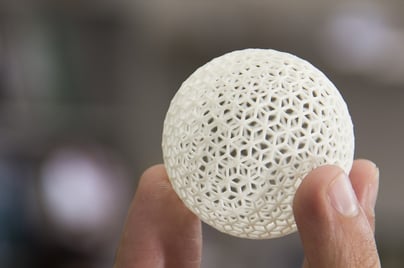
3D printing is ground-breaking technology that has not only made engineering faster, cheaper, and easily accessible, it has also advanced our capability of being creative and precise at the same time. And although 3D printing might seem like time-travel into the future, it has actually been around for a while, being mostly used industrially. So, yes, there is some explaining to be done.
What is 3D printing?
3D printing is a type of additive manufacturing that includes turning a digital three-dimensional design into a physical object by printing it layer by layer.
This process was invented by Chuck Hull in 1983 and was first called “stereolithography.” The original method incorporated printing layers of light curable liquid onto each other. Materials that can alter their physical state or are capable of solidification eventually entered the developing industry of 3D printing and now allow us to transition ideas into objects like never before.
What is the 3D printing process?
Before an object could be printed, it needs to be created as a 3D model, designed with the help of special software and computer-aided (CAD) tools. Those designs are first sliced digitally. "Slicing" means dividing the digital design into hundreds and sometimes even thousands of thin horizontal layers, which would then be printed sequentially to create the final complete object.
However, no matter how well you slice a 3D design, the precision, variety and toughness of the final object will be determined by the type of the 3D printer and matching material you decide to use. As you probably guessed, there is more than one way of printing a 3D object, each offering a variety of color and material. This is why some methods are more suitable for industrial technology while others work great with prototyping minor objects that are smaller or more fragile.
Despite the differences, all printers are additive, meaning they add layer on layer until the shape and details of the object are complete.
How do different 3D printers work?
Here are some of the most popular 3D printers.
- Fused Deposition Modeling is the most affordable 3D printing technology. Materials can range from simple plastic-based substances, to nylon, bronze, fiber and wood. Plastic-based materials give the most freedom with color selection.
- Stereolithography and Digital Light Processing (SLA & DLP) uses a light source to solidify a layer of liquid resin onto another. The only material that works with these printers is resin, and you can select one of its many varieties. This process produces the highest detail, which is why it’s recommended to use for small objects that require sharp precision. It's not recommended for printing large objects.
- Selective Laser Sintering is often used for industrial purposes. These printers work with powdered material that is melted and solidified by a laser.
- Material Jetting works by shooting layers of liquid photopolymer onto a build tray, layer by layer. The liquid is instantly solidified by UV light. At the end of the process, the supporting tray is removed and the object is ready. With this technology, precision can be improved by introducing gel-like support that can be removed when the printing is complete. Material Jetting is usually used for industrial purposes, some printers can even use multiple jets, allowing different combinations of color and material.
- Binder Jetting also uses powdered material but instead of firing up laser to solidify it, the printer extracts a binding agent from the nozzle that binds each layer to the other. Compared to Selective Laser Sintering, Binder Jetting is a more affordable industrial solution, demanding less energy but also producing less strength.
- Selective Laser Melting and Electron Beam Melting are both similar to Selective Laser Sintering printers. Just like SLS, these printers print on powdered material using a high heat source. This method is often used to print metal objects because its heat source is extremely powerful. Selective Laser Melting uses a high power laser, while Electron Beam Melting operates an electron beam. These printers are popular for industrial use because they can print materials like titanium, aluminum, nickel, cobalt-chrome, and even steel.
Who needs 3D printing?
Although 3D printing is just becoming widespread for industrial and mainstream companies, its benefits, such as high precision and affordability over any other method, are impeccable. 3D printed objects find their purpose in the automotive and medical industries, aircraft and aerospace manufacturing, architecture, consumer goods, and so on.
Examples are endless. Formula 1 racing teams use 3D printing to develop prototypes of custom parts that can increase performance during the race. And this is only one instance.
One of the most popular examples comes from Costa Rica and is an inspiring story of the benefits of 3D technology used in the biomedical field. Many people have heard the story of Grecia the toucan, whose upper beak was slashed off by attackers, leaving the bird incapable of eating, drinking, or maintaining a normal body temperature that is regulated by the beak itself. Back in 2015, Grecia the toucan sparked worldwide outrage and resulted in the passing of tough animal protection laws in Costa Rica and the rest of the world.
Within a year, Grecia became the first in its species to receive a prosthetic beak that was 3D printed to match its health condition, habits, and vital needs to maintain a normal life. And this is just the beginning.
Usage stories don’t stop here; companies and hospitals around the world use 3D printing to develop custom hearing aids, braces, retainers, and prosthetics designed to specifically fit the ear and jaw of patients. 3D printers allow architects to push the boundaries of their creativity, printing spectacular designs as small prototypes before they are turned to their real-life versions. 3D printing is a technology breakthrough that not only can grant a full life to a patient with hearing or other problems, but it also makes the world around us a little more stunning.

